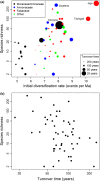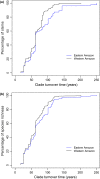Fast demographic traits promote high diversification rates of Amazonian trees
- PMID: 24589190
- PMCID: PMC4285998
- DOI: 10.1111/ele.12252
Fast demographic traits promote high diversification rates of Amazonian trees
Abstract
The Amazon rain forest sustains the world's highest tree diversity, but it remains unclear why some clades of trees are hyperdiverse, whereas others are not. Using dated phylogenies, estimates of current species richness and trait and demographic data from a large network of forest plots, we show that fast demographic traits--short turnover times--are associated with high diversification rates across 51 clades of canopy trees. This relationship is robust to assuming that diversification rates are either constant or decline over time, and occurs in a wide range of Neotropical tree lineages. This finding reveals the crucial role of intrinsic, ecological variation among clades for understanding the origin of the remarkable diversity of Amazonian trees and forests.
Keywords: Diversity; generation time; traits; tropical forest; turnover.
© 2014 The Authors. Ecology Letters published by John Wiley & Sons Ltd and CNRS.
Figures




References
-
- Bailey NTJ. The Elements Of Stochastic Processes with Applications to the Natural Sciences. New York, USA: John Wiley & Sons; 1964.
-
- Baker TR, Phillips OL, Laurance WF, Pitman NCA, Almeida S, Arroyo L, et al. Do species traits determine patterns of wood production in Amazonian forests? Biogeosciences. 2009;6:297–307.
-
- Burnham KP. Anderson DR. Model selection and inference: a practical information-theoretic approach. New York: Springer Verlag; 2002.
-
- Condit R. CTFS R Package. 2012. URL http://ctfs.arnarb.harvard.edu/Public/CTFSRPackage. Last accessed 1 September 2013.
Publication types
MeSH terms
LinkOut - more resources
Full Text Sources
Other Literature Sources

